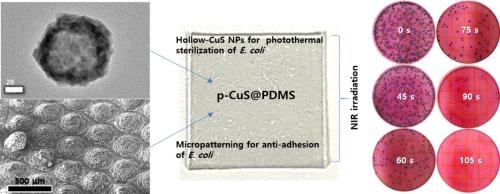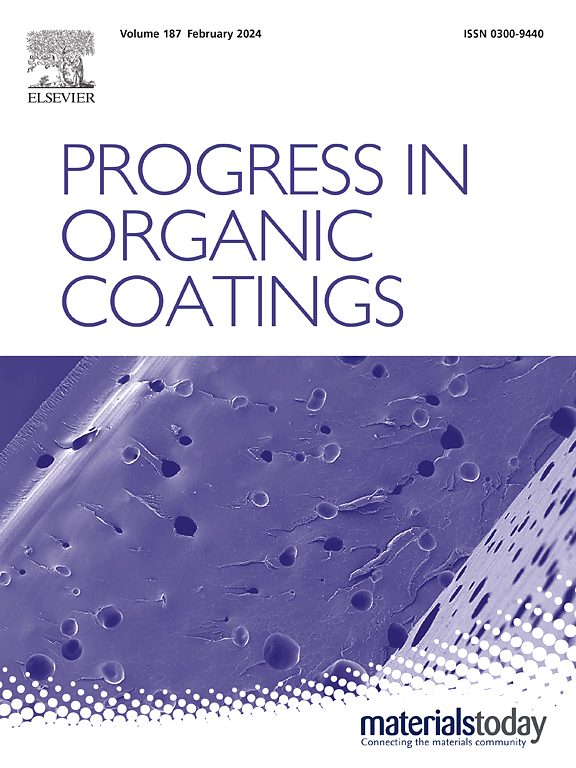Micropatterned CuS@PDMS films with anti-adhesive property for photothermal sterilization
IF 7.3
2区 材料科学
Q1 CHEMISTRY, APPLIED
引用次数: 0
Abstract
This study presents the development of micropatterned polydimethylsiloxane (PDMS) films with hollow CuS NPs (p-CuS@PDMS) designed for both anti-adhesive and photothermal sterilization applications. Hollow CuS nanoparticles (NPs) synthesized via the Kirkendall effect were incorporated into PDMS films to enhance the photothermal conversion. Micropatterning, achieved through a yogurt lid templating method, increased surface roughness and hydrophobicity and significantly reduced bacterial adhesion. The improved anti-adhesive properties were demonstrated by water contact angle measurements, which showed an increase of 24° from 103° to 127° for the micropatterned p-CuS@PDMS films. Under near-infrared (NIR) irradiation, the p-CuS@PDMS films achieved a temperature increase of 91 °C with a photothermal conversion efficiency of 73 %, which is much higher than the 61 °C achieved by plain PDMS. The presence of CuS NPs in the PDMS matrix improved the bacterial inactivation rates, with p-CuS@PDMS achieving a 99 % bacterial kill rate after 90 s of irradiation. Although the anti-adhesive properties were influenced more by micropatterning, the combination of CuS and micropatterning provided a synergistic effect. These results demonstrate the potential of p-CuS@PDMS films for applications in healthcare and packaging, where effective sterilization and bacterial resistance are critical.

用于光热灭菌的具有抗粘附特性的微图案 CuS@PDMS 薄膜
本研究介绍了具有空心 CuS NPs(p-CuS@PDMS)的微图案聚二甲基硅氧烷(PDMS)薄膜的开发情况,该薄膜设计用于防粘和光热杀菌应用。通过 Kirkendall 效应合成的中空 CuS 纳米粒子(NPs)被纳入 PDMS 薄膜,以增强光热转换。通过酸奶盖模板法实现的微图案化增加了表面粗糙度和疏水性,显著降低了细菌粘附性。水接触角测量结果表明,微图案化 p-CuS@PDMS 薄膜的抗粘附性从 103°提高到 127°,提高了 24°。在近红外(NIR)照射下,p-CuS@PDMS 薄膜的温度升高了 91 ℃,光热转换效率达到 73%,远高于普通 PDMS 的 61 ℃。PDMS 基质中 CuS NPs 的存在提高了细菌的灭活率,在照射 90 秒后,p-CuS@PDMS 的细菌杀灭率达到 99%。虽然抗粘附性能更多地受到微图案化的影响,但 CuS 与微图案化的结合产生了协同效应。这些结果证明了 p-CuS@PDMS 薄膜在医疗保健和包装领域的应用潜力,在这些领域中,有效的灭菌和抗细菌性是至关重要的。
本文章由计算机程序翻译,如有差异,请以英文原文为准。
求助全文
约1分钟内获得全文
求助全文
来源期刊

Progress in Organic Coatings
工程技术-材料科学:膜
CiteScore
11.40
自引率
15.20%
发文量
577
审稿时长
48 days
期刊介绍:
The aim of this international journal is to analyse and publicise the progress and current state of knowledge in the field of organic coatings and related materials. The Editors and the Editorial Board members will solicit both review and research papers from academic and industrial scientists who are actively engaged in research and development or, in the case of review papers, have extensive experience in the subject to be reviewed. Unsolicited manuscripts will be accepted if they meet the journal''s requirements. The journal publishes papers dealing with such subjects as:
• Chemical, physical and technological properties of organic coatings and related materials
• Problems and methods of preparation, manufacture and application of these materials
• Performance, testing and analysis.
 求助内容:
求助内容: 应助结果提醒方式:
应助结果提醒方式:


